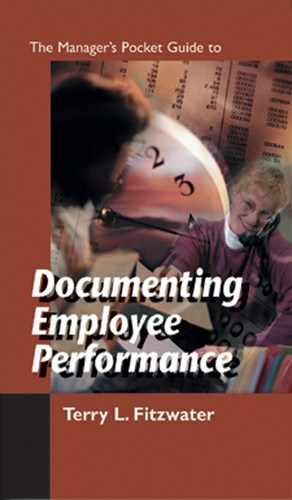DOCUMENTING DISCIPLINE: YOUR PRIMARY GOAL
,In working through this chapter, and whenever documenting the disciplinary process, keep in mind the following:
• Clarity is your main goal. The document should …
— be easy to understand
— succinctly present the facts and the supporting details of the problem
— convey expectations for change
— specify the consequences of noncompliance to requested performance improvement
— set specific and achievable goals for performance improvement
— demonstrate your company’s willingness to work with the employee over a given period of time
• Objectivity facilitates clarity. Keep to the hard facts, describing the problem via those facts. In good documentation, nothing is subject to interpretation. If you aim to be objective, you will more easily attain your goal of clarity.
• Completeness facilitates clarity. Include all the facts.
For example, a problem definition such as “Your tardiness is a concern” may seem clear, but not if we compare it to this:
Your continuing instances of tardiness, five in the last month on January 5, 10, 21, 27,and 28, strain the productivity of the department and your coworkers, and the tardy behavior cannot continue any longer.
The employee knows that the tardiness is indeed a problem and gets a complete picture of that problem: it is continual; it affects others; it cannot continue. There also is little room for interpretation, filling the requirement of objectivity. The meaning is clear to the employee and to any third party reviewing the document. It is just what you need to strive for in your documentation efforts.
Also, notice the dates of the tardy behavior are defined. While it is not essential it is a good practice to be this specific. If you do not include the dates make sure you convey that information to the employee and retain written evidence of each incidence in the file. But, as a standard rule remember this: dates, times, and incidences will always strengthen a letter.
DOCUMENT VALIDATION
It is important to know from the start these two technicalities:
1. You must ensure the employee receives a copy of the document, no matter what step of the disciplinary process you are taking.
2. You must validate the document by obtaining proof the employee received a copy of it.
The first technicality is easy to cover. Simply give the employee a copy of any formal discussion.
The second technicality requires getting the employee to sign the original document and then giving him or her a copy of it. But what if the employee refuses to sign? Then note at the bottom of the document “Hand-delivered to [name of employee] this [date].” Either act—signing or hand delivering the document—helps to validate the document. As a matter of note, this is also the time to guarantee the document’s protection by placing it in the employee’s file.
